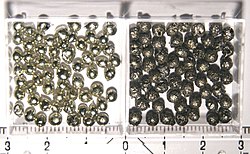Tin
This silvery, malleable post-transition metal is not easily oxidized in air and is used to coat other metals to prevent corrosion. The first alloy, used in large scale since 3000 BC, was bronze, an alloy of tin and copper. After 600 BC pure metallic tin was produced. Pewter, which is an alloy of 85–90% tin with the remainder commonly consisting of copper, antimony and lead, was used for flatware from the Bronze Age until the 20th century. In modern times tin is used in many alloys, most notably tin/lead soft solders, typically containing 60% or more of tin. Another large application for tin is corrosion-resistant tin plating of steel. Because of its low toxicity, tin-plated metal is also used for food packaging, giving the name to tin cans, which are made mostly of steel.
Occurrence
Tin is generated via the long S-process in low-to-medium mass stars (with masses of 0.6 to 10 times that of Sun). It arises via beta decay of heavy isotopes of indium.
Tin is the 49th most abundant element in the Earth's crust, representing 2 ppm compared with 75 ppm for zinc, 50 ppm for copper, and 14 ppm for lead.
Tin does not occur as the native element but must be extracted from various ores. Cassiterite (SnO2) is the only commercially important source of tin, although small quantities of tin are recovered from complex sulfides such as stannite, cylindrite, franckeite, canfieldite, and teallite. Minerals with tin are almost always associated with granite rock, usually at a level of 1% tin oxide content.
Because of the higher specific gravity of tin dioxide, about 80% of mined tin is from secondary deposits found downstream from the primary lodes. Tin is often recovered from granules washed downstream in the past and deposited in valleys or under sea. The most economical ways of mining tin are through dredging, hydraulic methods or open cast mining. Most of the world's tin is produced from placer deposits, which may contain as little as 0.015% tin.
About 253,000 tonnes of tin have been mined in 2011, mostly in China (110,000 t), Indonesia (51,000 t), Peru (34,600 t), Bolivia (20,700 t) and Brazil (12,000 t). Estimates of tin production have historically varied with the dynamics of economic feasibility and the development of mining technologies, but it is estimated that, at current consumption rates and technologies, the Earth will run out of tin that can be mined in 40 years. However Lester Brown has suggested tin could run out within 20 years based on an extremely conservative extrapolation of 2% growth per year.
Economically recoverable tin reserves
Year Million tonnes
1965 4,265
1970 3,930
1975 9,060
1980 9,100
1985 3,060
1990 7,100
2000 7,100
2010 5,200
Secondary, or scrap, tin is also an important source of the metal. The recovery of tin through secondary production, or recycling of scrap tin, is increasing rapidly. Whereas the United States has neither mined since 1993 nor smelted tin since 1989, it was the largest secondary producer, recycling nearly 14,000 tonnes in 2006.New deposits are reported to be in southern Mongolia, and in 2009, new deposits of tin were discovered in Colombia, South America, by the Seminole Group Colombia CI, SAS.
| Symbol | Sn | |
| Atomic Number | 50 | |
| Atomic Weight | 118.71 | |
| Oxidation States | +2,+4 | |
| Electronegativity, Pauling | 1.96 | |
| State at RT | Solid, Metal | |
| Melting Point, K | 505.1 | |
| Boiling Point, K | 2543 |
Appearance and Characteristics
Harmful effects:
Tin is considered to be non-toxic but most tin salts are toxic. The inorganic salts are caustic but of low toxicity. Organometallic compounds of tin are highly toxic.
Characteristics:
- Tin is a silvery-white, soft, malleable metal that can be highly polished.
- Tin has a highly crystalline structure and when a tin bar is bent, a ‘tin cry’ is heard, due to the breaking of these crystals.
- It resists oxygen and water but dissolves in acids and bases. Exposed surfaces form an oxide film. When heated in air, tin forms tin(IV) oxide (stannic oxide) which is feebly acidic.
- Tin has two allotropic forms at normal pressure, gray tin and white tin. Pure white tin slowly tends to become the gray powder (gray tin), a change commonly called ‘tin pest’ at temperatures below 13.2 oC. Gray tin has no metallic properties at all. Commercial quality tins are resistant to tin pest as a result of the inhibiting effects of minor impurities.
Uses of Tin
- Tin is used as a coating on the surface of other metals to prevent corrosion. ‘Tin’ cans, for example, are made of tin-coated steel.
- Alloys of tin are commercially important in, for example, soft solder, pewter, bronze and phosphor bronze.
- Tin chloride (stannous chloride, SnCl2) is used as a mordant in dyeing textiles and for increasing the weight of silk.
- Stannous fluoride (SnF2) is used in some toothpastes.
Time lapse movie of tin’s allotropes. Metallic white tin becomes non-metallic gray tin. This is known as ‘tin pest’ and is a problem at low temperatures. 1 second of movie equals one hour in real time.
A piece of zinc metal in tin chloride solution. Zinc is more reactive than tin, so zinc chloride forms, replacing the tin chloride. Crystals of pure metallic tin begin to form on the zinc.
